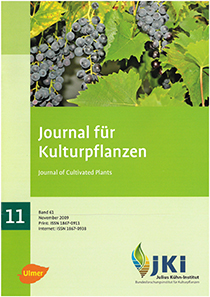Effects of different types of soil management on yield, plant health and quality of Vitis vinifera (cv. Dornfelder)
Keywords:
Biological plant protection, soil management, yield, plant health, quality, Vitis vinifera, herbs, essential oils, Thymus ssp., Artemisia ssp., Foeniculum ssp., micro nutrientsAbstract
This article presents results of a field trial on effects of different types of soil management on yield, plant health and quality of Vitis vinifera (Dornfelder). It was investigated if and why straw cover, conventional mechanical weed control, winter cropping and permanent grass cover differ with regard to yield, plant health and quality. Theoretically, a soil management that favours organic matter input is expected to result in higher soil fertility, higher microbial activity and lead to long-term more stable yields. In a randomized control study on the experimental field of the Julius Kühn-Institut, Federal Research Centre for Cultivated Plants in Berlin-Dahlem (formerly the Federal Biological Research Centre for Agriculture and Forestry) 700 Dornfelder-vines were planted and their interrangs were laboured according to the above mentioned soil management systems. Special concern was dedicated to the development of macro and micro nutrient content in the soil, in the leaves and finally in the berries.
The analysis showed a remarkably higher mineralization of nitrogen (Nmin) in the soil when the interrang was covered with straw. This correlated with the highest yield and the highest potential degree (vol. alc.) of all cases under investigation. Furthermore soil analysis with ICP-OES revealed that contents of potassium and calcium had increased significantly in soils treated with straw. On the other hand, contents of micro nutrients as B, Fe, Cu, Mn and Zn were higher in winter wheat/winter rye plots. But this surplus was not transferred to the berries, whereas contents of the above mentioned micronutrients were highest in the berries from straw cover soil management systems. With regard to plant health, no differences were detected between the different types. A microvinification resulted in satisfactory sensoric quality with red wine of winter cropping plots outstanding in taste and colour followed by straw cover soil management systems.
In addition, a new type of labouring the soils under the vines – the rangs themselves – was established to investigate the effects of herbs with volatile essential oils. It is well known that Thyme (Thymus ssp.), Mugwort (Artemisia ssp.) and Fennel (Foeniculum ssp.) can exhibit fungicide effects in vitro towards Botrytis cinerea. In 2006, these herbs were planted in early spring under Dornfelder -vines. Surprisingly, Fennel gave the best sensoric results after microvinification and the highest yield compared to Mugwort and Thyme. The Fennel cropping system revealed also the highest contents of copper, manganese and zinc in the soil of the respective rang but the opposite was true for the content of these micronutrients in the pulp. All cropping systems contained considerably more soil micronutrients in the course of the vegetation. This effect was possibly due to plant-root-interactions which led to a release of formerly fixed micronutrients (decomplexation).
DOI: 10.5073/JfK.2009.11.02, https://doi.org/10.5073/JfK.2009.11.02








